Ghidorah, The Three-Headed Monster: The Godzilla Movie to Rise Again in 2019
It’s been a month since Kong: Skull Island came out and grossed over half a billion dollars globally, so I feel safe in 1) discussing the post-credits stinger without a spoiler freak-out, and 2) predicting we’ll indeed see Legendary Picture’s planned Godzilla vs. King Kong film in a few years. Warner Bros. isn’t leaving franchise money on the table, especially with their DC pictures in a shaky place.
But the movie arriving before the Radioactive Terror and the Eighth Wonder smash heads is promised in Skull Island’s post-credits stinger. Godzilla: King of the Monsters, to be directed by Michael Dougherty and slated for release in March 2019, is the third installment in the Legendary Pictures Kaijuverse. Kong: Skull Island contains numerous references that it occurs in the same universe as the 2014 Godzilla, such as the presence of the monster-researching Monarch Organization and mention of the Pacific atomic test originally targeted at killing Godzilla.
But the major shared universe set-up arrives after the credits fade. Anyone up on their Godzilla franchise news already knew what was coming because of an announcement made at San Diego Comic-Con in July 2014 about which monsters were planned for the Godzilla sequel. But receiving actual visual confirmation, on a huge movie screen, of the arrival of Mothra, Rodan, and King Ghidorah … so beautiful. Best post-credits stinger of my life. Five hankies.
“They’re actually doing it,” I screamed in my head. “They’re actually remaking the 1964 Ishiro Honda-directed classic Ghidorah, The Three-Headed Monster. Godzilla, Mothra, and Rodan team-up to smack down King Ghidorah, the aureate space invader!”
Okay, maybe we won’t exactly see a Ghidorah remake, as I doubt Godzilla: King of the Monsters ‘19 will have a subplot about a millennia-old Venusian intelligence seizing the mind of a princess from a fictional island and a police detective trying to stop assassins from killing her while they dodge around monsters wrecking everything in sight. Ah, but therein lies a tale…
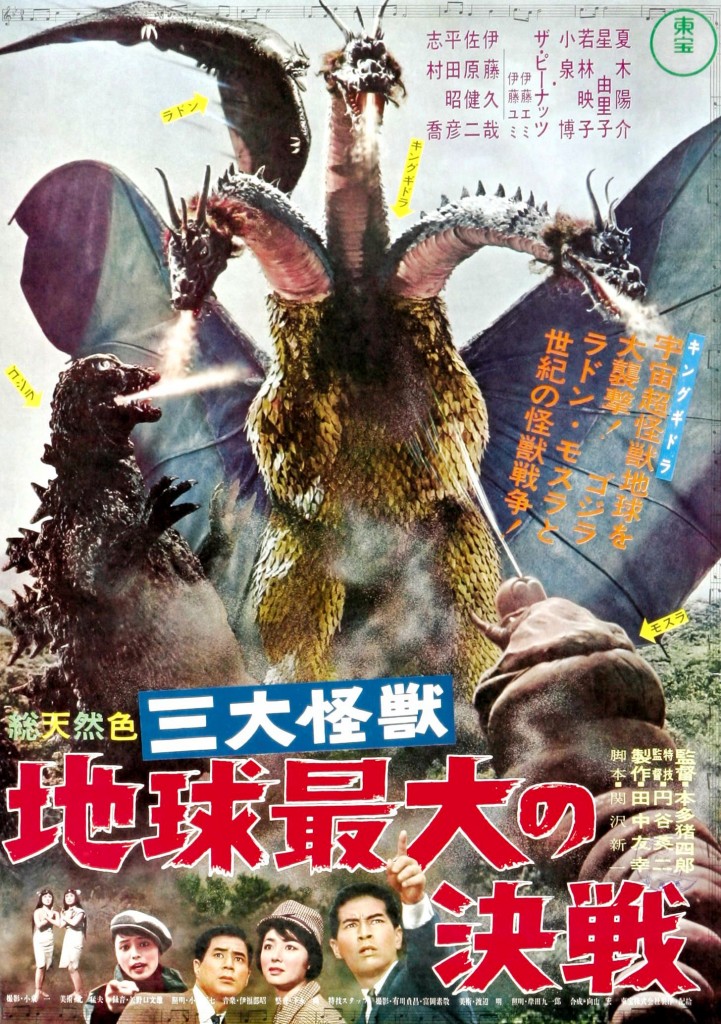 Japan’s Mid-Sixties Kaiju Boom
Japan’s Mid-Sixties Kaiju Boom
If you want a more in-depth look at this period of the Godzilla series, I refer you to Part 2 of my History of Godzilla on Film. The short version: In 1962, after Toho scored a gargantuan hit with King Kong vs. Godzilla, the studio quickly put their main monster against a popular hometown creature, Mothra. Mothra vs. Godzilla was a hit in early 1964, and Toho had another movie ready to go before the cameras and reach screens by the end of the year.
The Mothra vs. Godzilla follow-up doubled-down with four kaijus (giant monsters) sharing the poster. Godzilla and Mothra returned, joined by Rodan, who had headlined a movie in 1956. But the new monster received top billing, at least in the English title: an extraterrestrial engine of destruction named King Ghidorah. A villainous monster through and through, King Ghidorah permitted the Godzilla series to make a major transition. For the first time, Godzilla could act the “hero,” thus laying the groundwork for the next decade of films — and more after that.
Godzilla as Superhero rankles a segment of kaiju fandom. But the series wouldn’t have continued without this transformation. Plus, there was no way to prevent it, not with special effects wizard Eiji Tsuburaya’s love for entertaining children and his wish to lighten the monster action. The audience for Godzilla and other Japanese effects movies in the 1960s was skewing younger, and Tsuburaya was happy to skew along with it. The humanist themes of director Ishiro Honda diminished, although Honda maintained a sure hand over the proceedings. But it was hard to say “no” to the box office receipts or to Eiji Tsuburaya, one of the most powerful creative people at Toho Studios in the ‘60s.
However, this is jumping ahead. Ghidorah, The Three-Headed Monster is the tipping point, not a full kiddie monster-hero fable. It’s no Godzilla vs. Hedorah. It’s the first kaiju monster rally, and the balance between Ishiro Honda’s serious drama (a mobster/spy story, a message of cooperation) and Tsuburaya’s anthropomorphized beast antics (Godzilla and Rodan smashing a rock volley between each other, Mothra’s twin fairies translating a detailed monster conversation) is still even. The final result is a best-of-both-worlds scenario and a high point in giant monster cinema. And it’s going to be a $150 million+ blockbuster in two years! I still have difficulty wrapping my mind around that.
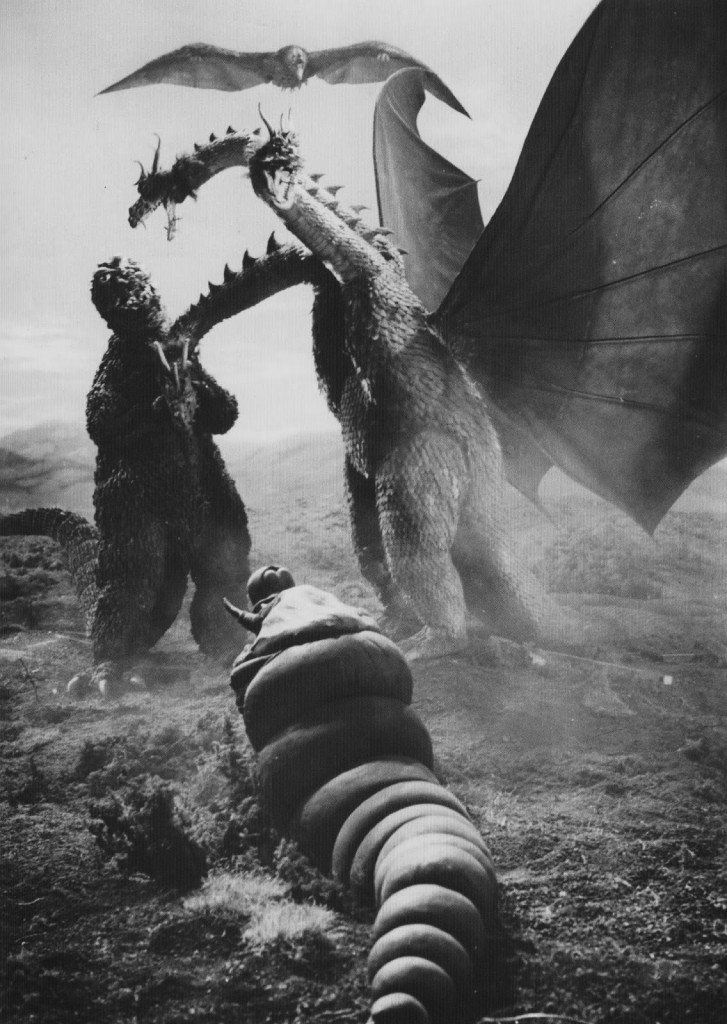 The Three Monster Defenders of Earth
The Three Monster Defenders of Earth
The movie’s Japanese title, San Daikaiju: Chikyu Saidai no Kessen, translates as “Three Giant Monsters: Greatest Battle on Earth.” But wait a minute, there are four monsters. Is this a Marx Brothers thing and poor Rodan is getting ostracized as Zeppo? No, the three monsters of the title are the three established players in the Toho stable who form a Kaiju Avengers to battle an alien threat: Godzilla (Gojira), Mothra (Mosura), and Rodan (Radon). It’s the fifth film for Godzilla, third for Mothra, and second for Rodan.
The kaijus have undergone a personality revamp — which is that they now have full personalities. Special Effects Supervisor Eiji Tsuburaya had pushed since King Kong vs. Godzilla for a lighter, anthropomorphic approach to the monsters, and he won out here. Godzilla, Rodan, and Mothra are distinct personas (the Marx Brothers analogy isn’t too far off the mark) who have recognizable human interactions. Rodan and Godzilla take turns to laugh at the other’s humiliation (Godzilla has to take a seat on a rock because the laughter is too much), Godzilla taunts King Ghidorah and offers to help Mothra climb a hill by tagging onto its tail, and King Ghidorah is a snickering jerk who appears progressively annoyed at the kaiju gang-up. At the end, Godzilla and Rodan stand serenely on an ocean cliff watching Mothra return to Infant Island. There’s no need to scare away Rodan and Godzilla; they stay on the Japanese mainland as the words “The End” come up. This is an amazing change in kaiju film tactics.
Godzilla
Ghidorah, The Three-Headed Monster is the initial time Godzilla acts heroically, although still a destructive force. For most of the movie, Godzilla stays locked in a tussle with Rodan that wracks up immense collateral damage. But once convinced King Ghidorah is a bigger threat — or at least beating up Ghidorah would be more fulfilling — Godzilla throws in. That moment, when Godzilla angrily attacks King Ghidorah because Mothra asked politely for help is the turning point in the G-series. Godzilla, portrayed consistently as a danger that must be destroyed or repulsed, suddenly is the Good Guy — and a human pronoun like “he” feels appropriate for the first time. The Godzilla costume is the same from Mothra vs. Godzilla, the most beautiful suit of the series, with slight modifications to the head to keep the upper lip from wobbling.
Rodan
The flying monster Rodan had only made a single previous appearance, in its eponymous 1956 movie. There were two Rodans in that film, a mated pair, and both seemed to perish in Mt. Aso during the climax. One of them resurrects from the volcano (no mention is made of the other one) and goes straight to attacking Godzilla. Rodan never looked as stunning as it did in its original movie, and here has a somewhat goofy appearance with large yellow eyes. But Rodan still astonishes as a flying creature, at one point pulling off a sharp bank turn to smash head-first into King Ghidorah and bring the dragon down. Rodan is also the most comic of the quartet, a loveable goof.
Mothra
Mothra was the second-best established Japanese kaiju in 1964, headlining a titanically successful solo film and then battling Godzilla to defeat four years later. Mothra serves as the straight man/woman and the interlocutor who convinces the other monsters to assemble for the good of Earth in a scene that’s frankly incredible. The same mechanical larva prop constructed for Godzilla vs. Mothra is used, and Mothra never transforms into its adult stage; there wasn’t time to fit it in, and Mothra needed to remain the least powerful of the four creatures for the story to work. Somebody had to be the scrappy underdog to convince the big bruisers to get in on the action. As usual, Mothra comes with the Shobijin, the miniature twin fairies played by pop-singing duo Emi and Yumi Ito. The Shobijin do a guest-spot singing to Mothra on a “Where Are They Now?” television show during the otherwise monsterless first half hour.
The Nemesis: King Ghidorah
When the movie opens, Japan is experiencing a series of odd occurrences: unusual heat in January, an unseasonal outbreak of encephalitis, meteor showers. A meteorite strikes in the Hida Mountain Range, and a scientific expedition trudges out to study the rock’s bizarre magnetic properties. But the space-rock is actually the transport mechanism for the movie’s villain, King Ghidorah — a triple-headed dragon traveling the cosmic winds to annihilate populated worlds. Thousands of years ago, the advanced civilization of Venus was one of its victims. Now it’s Earth’s turn to melt under the power of King Ghidorah’s gravity beams and pompous attitude.
Towering almost a hundred meters with three heads, enormous wings, a split tail, and a covering of golden triangular scales, King Ghidorah is one of the most astonishing creations in Japanese science-fiction films. Its design mixes elements of the Chinese dragon with the eight-headed dragon Orochi from Japanese legends, but King Ghidorah has the special pop culture “wow factor” that VFX master Eiji Tsuburaya knew how to execute to perfection.
Ghidorah represents a high point in the shift from the documentary style of the first Godzilla to the colorful and fanciful. Where Godzilla’s first monster opponent, Anguirus (in Godzilla Raids Again), was drawn from the paleontology record, King Ghidorah bursts from myths and children’s dreams. Yet King Ghidorah isn’t a childlike creation, but a full-blown nightmare demon. It’s wonder and fear combined. This makes it arguably the quintessential beast of the kaiju genre, more so than even Godzilla.
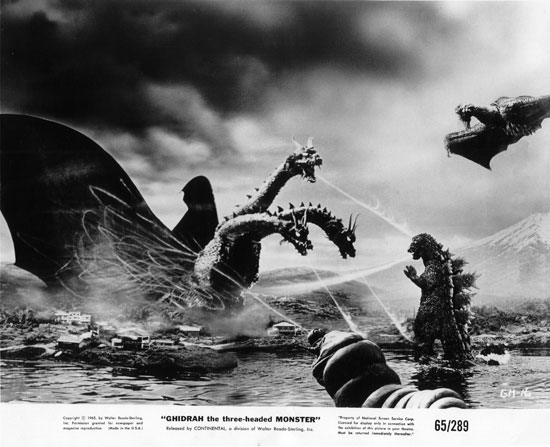 King Ghidorah’s crowning moment in the movie is the few minutes of gravity bolt destruction it lances across Tokyo, which interrupts a government debate over whether Mothra will come to Japan’s assistance. Ghidorah streaks lightning bolts across the city’s buildings and structures, demolishing them in anarchic jubilation. Tokyo Tower is struck in the middle and melts, gradually tumbling over during the rest of the devastation until it hammers down on the skyline like a death knell. The special effects work here is spectacular and the footage would repeat over and over again as filler in the lower-budgeted 1970s movies.
King Ghidorah’s crowning moment in the movie is the few minutes of gravity bolt destruction it lances across Tokyo, which interrupts a government debate over whether Mothra will come to Japan’s assistance. Ghidorah streaks lightning bolts across the city’s buildings and structures, demolishing them in anarchic jubilation. Tokyo Tower is struck in the middle and melts, gradually tumbling over during the rest of the devastation until it hammers down on the skyline like a death knell. The special effects work here is spectacular and the footage would repeat over and over again as filler in the lower-budgeted 1970s movies.
Ghidorah also stars in the best single VFX shot, with the camera photographing the monster through a Shinto gate (torii). The gate looks imposing in the foreground, framing the triple-headed monster, who then blasts the gate so it cracks apart and crashes forward toward the camera. It’s breathtaking in explicating the sheer destructive size and scope of this creature. King Ghidorah laughs at your puny human religions! And your infrastructure, television towers, small farming villages… an equal opportunity alien jerk.
The final confrontation with King Ghidorah facing the Big-G, the Flying-R, and the Small-M is near the top of the heap for kaiju showdowns. Tsuburaya and his effects team orchestrate the build as the three monsters work together to defeat Ghidorah, track-switching smoothly from humorous character bits (Godzilla gets roasted in the rump) to amazing power moves (Ghidorah flipping Mothra end-over-end, Godzilla hurling a cocooned Ghidorah by the tails). It’s one of the finest effects set-pieces of the kaiju age.
Providing King Ghidorah with the best assistance outside of the VFX crew is composer Akira Ifukube, who has his hands full with a stack of monster themes. King Ghidorah arrives with a booming new six-note theme matching its malevolence, one Ifukube would revisit in the future. Combined with dueling Rodan-and-Godzilla themes (the Rodan wailing trumpet motif is re-worked from a native chant Ifukube wrote for 1958’s Varan) and some lovely mountain landscape music, and you have one of the finest Godzilla scores.
The Humans: Assassins, Cops, And a Possessed Princess
So far I’ve only briefly touched on the action away from the monsters. The movie has a solid story that downplays the scientific and military focus of earlier kaiju films to emphasize suspense and crime drama. The expedition to the Hida Mountains to study the meteorite is only a small section of the story, providing hints of the villain monster to come while elsewhere an espionage plot with an alien possession and a touch of the popular yakuza gangster genre unfolds. This storyline might have sustained a fun action-thriller with an SF twist even without the monsters. (Toho later made a movie much like that, 1974’s ESPY.)
Screenwriter Senichi Sekizawa, who penned many Toho science fiction movies in the 1960s, centers the human tale on a police drama/espionage caper — and makes it work. A Tokyo police detective assigned to defend an amnesiac princess from a band of foreign assassins is a good hook for a crime drama. That the princess is possessed with the intelligence of a prophetic Venusian means more crazy fun and an excuse to tie everything into the monsters that are making life more difficult for Shindo (Yosuki Natsuke), the beleaguered cop on protection duty.
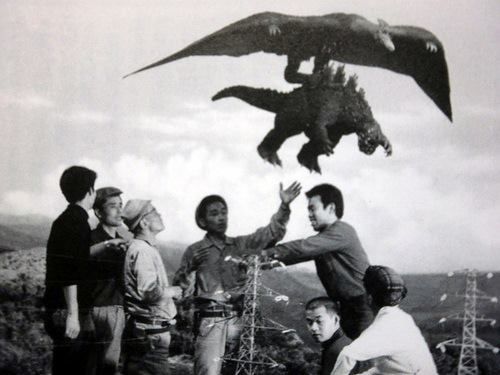 Director Ishiro Honda is adept at making “cartoony assassins vs. stalwart detective” feel real enough to keep the audience interested until the thirty-minute point when Rodan and Godzilla barge into the proceedings. Using the sleight-of-hand of the alien prophetess predicting the monsters’ arrival and King Ghidorah’s apocalyptic goal folds together the plot strands. Wouldn’t you want your final assassination showdown to take place with the constant danger of a four-way monster tussle occurring overhead?
Director Ishiro Honda is adept at making “cartoony assassins vs. stalwart detective” feel real enough to keep the audience interested until the thirty-minute point when Rodan and Godzilla barge into the proceedings. Using the sleight-of-hand of the alien prophetess predicting the monsters’ arrival and King Ghidorah’s apocalyptic goal folds together the plot strands. Wouldn’t you want your final assassination showdown to take place with the constant danger of a four-way monster tussle occurring overhead?
Honda has help from a cast of familiar A-list Japanese actors who were part of his stock company: Akihiko Hirata (Dr. Serizawa from Godzilla), Takashi Shimura (Dr. Yamane from Godzilla, also star of some of Akira Kurosawa’s best films), Kenji Sahara (all-purpose monster movie utility player), Hideyo Amamoto (Dr. Who from King Kong Escapes), and Hiroshi Koizumi (leading man in Mothra). These are performers who can nail their parts with only a short bit of screentime.
The most memorable turns come from the striking Akiko Wakabayashi as Princess Salno and Hisaya Ito as Malmess, the killer assigned to off her. Wakabayashi would make a huge impact in the West in a few years as Aki in the Bond film You Only Live Twice, along with her King Kong vs. Godzilla co-star Mie Hama. Here she feels truly alien and bizarre when in Venusian mode, and her final scene where she thanks Shindo for saving her life, hinting at a romance that could never be, is a touching reminder that, yes, human heroes matter as well.
And Ito is so cool as the unflappable assassin who always wears sunglasses and never seems too perturbed about giant monsters getting in the way of him doing his job. That is, until the monsters drop an avalanche on him (blame Ghidorah for that one). But he manages to catch one of the boulders before his death. Special effects slip-up … or is Malmess just that awesome?
There are a few too many characters bumping around and story threads that don’t weave together, which are common troubles in Japanese SF. The UFO-watching cult in the opening scene only shows up once more to drop a needless theory about how Princess Salno escaped from the bomb that exploded her plane. (Aliens are involved, we don’t need any further explanation!) The expedition to investigate King Ghidorah’s meteorite also turns to nothing, leaving Professor Miura (Koizumi) with the thankless task of transporting the Shobijin to the finale so they can translate the monster-speak. There are a few vague hints at a romance between Miura and Naoko (Yuriko Hoshi), the police detective’s sister who’s also a reporter for a science television show. But the movie hasn’t time for this. Assassins and monsters are all you need.
Home Video Viewing Options
I’ve a bit of rep on Black Gate for making poor predictions about when certain movies will finally arrive on Blu-ray. However, I feel unfortunately confident about the slow arrival of a North American Blu-ray of Ghidorah, The Three-Headed Monster. The current North American video rights holders, Classic Media, has flat-out refused to make the shift to Blu-ray. Until another label like Kraken Releasing or Kino Lorber liberates the rights, I doubt we’ll see a stateside Blu-ray.
But the DVD is still available, and you can stream the movie through a number of services. It’s included in a Shout! Factory TV subscription, and can be purchased on Amazon VOD and Google Play. These are all the dubbed English version released under the slightly shortened title Ghidrah, The Three-Headed Monster. It has some cuts and reshuffled scenes, Venus is switched for Mars, and a few stock music cues, but it isn’t terrible as far as dubbed editions go. David Kalat on his commentary for the Classic Media DVD claims the English version is superior. This is crazy talk, but whatever. See the dubbed version anyway if that’s the easiest one to get.
Ryan Harvey is one of the original bloggers for Black Gate, starting in 2008. He received the Writers of the Future Award for his short story “An Acolyte of Black Spires,” and his stories “The Sorrowless Thief” and “Stand at Dubun-Geb” are available in Black Gate online fiction. A further Ahn-Tarqa adventure, “Farewell to Tyrn”, is currently available as an e-book. Ryan lives in Costa Mesa, California where he works as a professional writer for a marketing company. Occasionally, people ask him to talk about Edgar Rice Burroughs or Godzilla in interviews.
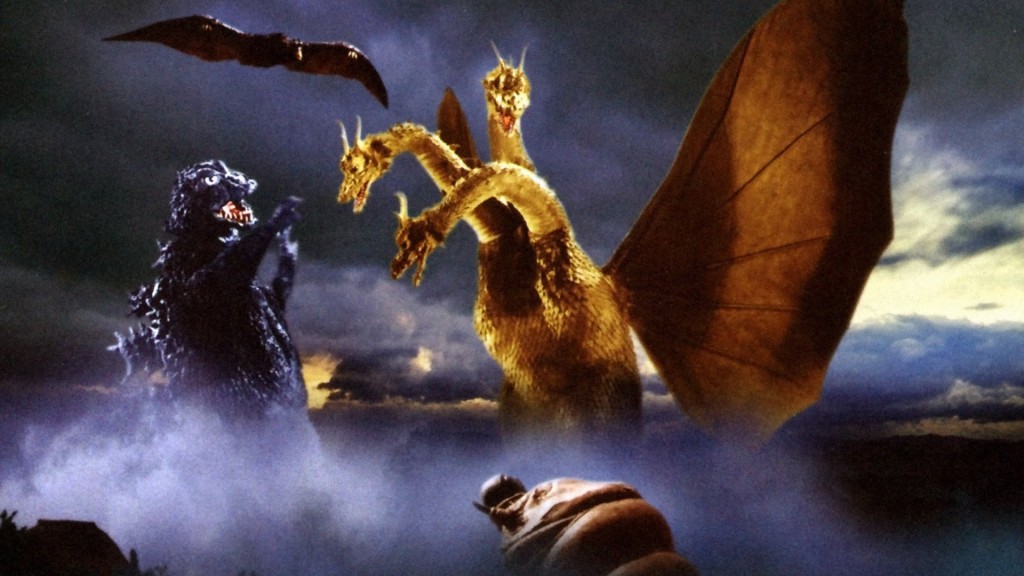
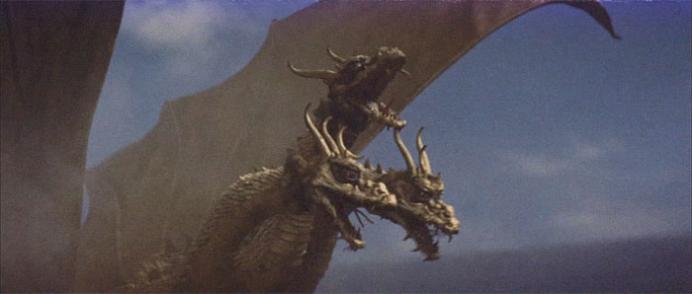
I think Ghidorah was my favorite even before I’d seen him in action — I remember buying a plastic model kit of Ghidorah laying waste to an airfield, complete with tiny little smashed fighter jets.
Speaking of Orochi, have you seen the movie? That might be worth a look at some point.
@Joe – Are your referring to The Birth of Japan, the Inagaki film from 1958, or the remake in 1994, Yamato Takeru (a.k.a. Orochi, the Eight-Headed Dragon)? I’ve seen both, but it’s been years, and the 1994 one is hard to get hold of today.
The sequel to this one, Godzilla vs. Monster Zero is my all-time favorite Godzilla movie and King Gidorah himself is my all-time favorite Japanese monster. I will definitely look forward to his on-screen return.
BTW, thanks for mentioning Amazon and Shout! Tv. I just added the Shout! app to my Fire TV stick and added several G-movies to my Amazon watchlist, including the ones that are free with the Shout! app. Sometime this weekend I will sit down and watch some giant monsters with my puppy on my lap. In other words, a freat weekend.
That last sentence was supposed to be a great weekend.
@Amy – Freat weekends can be a good time as well. Giant monsters make everything “great,” even “freat.”
It’s commonly known that “freat” is a conjunction of “great” and “fraught”, meaning “filled with or destined to result in.” Thus “freat” means “filled with or destined to result in great things!”
if you noticed in this movie godzilla never fired his ray at king ghidorah only at rodan
Yes, I means Orochi, the Eight-Headed Dragon — I hadn’t actually heard of Birth of Japan, which I now need to investigate …
I was also a fan of Mecha-Ghidorah and the various Ghidorah variations that appeared in the Rebirth of Mothra films.
Argh. And clearly I means “meant”, not “means”.
Ryan, after rewatching this movie today,I realized there is one specific connection to another topic of your Black Gate blogs: a Princess who thinks she’s a Martian. Wouldn’t that sort of make her A Princess of Mars?
@Amy – Weeeeeellll, not in the Japanese version. She’s a Venusian. I don’t know why the U.S. distributor made the change. So she’s a Princess of Venus except when U.S. custom laws intervene. You’ll have to ask Carson Napier about her, rather than John Carter. 🙂
@Joe – The Birth of Japan (released in the U.S. theatrically as The Three Treasures) is a massive 3+ hour epic that’s essentially the Ben-Hur of Japan. It’s from the director of the “Samurai” trilogy, stars Toshiro Mifune, has a score by Akira Ifukube, special effects by Eiji Tsubaraya, and features battle scenes, a volcano, floods, and Orochi the Dragon as the finale. I’d have written a full article about it here already if it were easily available in the U.S. Alas, this is not the case; the film needs to be better known.
I miss the days when you could tell who was an alien because they were wearing silver lame jumpsuits and plastic sunglasses.